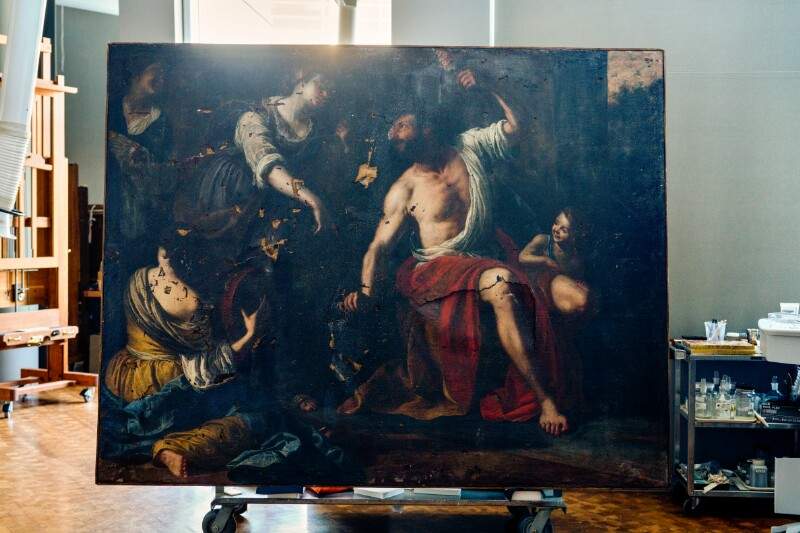New work by Artemisia Gentileschi: Getty confirms attribution of Hercules and Onphale
Artemisia Gentileschi ’s catalog is being enriched with a new work, according to the findings of the Getty Museum in Los Angeles, where restoration work is underway on a Hercules and Onphale preserved in Beirut’s Sursock Palace and which survived the Lebanese capital’s August 4, 2020, port explosion. The work, once restoration is completed in 2023, will be displayed at the Getty Center (next to the Lucretia recently acquired by the California museum), before returning to Beirut’s Sursock Palace. The same collection holds another work by Artemisia Gentileschi, the Magdalene, which was exhibited in Milan last year during the exhibition Le Signore dell’arte at the Palazzo Reale: the painting was shown with still damage from the explosion.
Analyses conducted at the Getty made it possible to confirm the attribution on which the conditional had been hovering until now: the painting had returned to scholarly attention just after the 2020 explosion. For the Magdalene had come confirmations from Riccardo Lattuada, an Artemisia Gentileschi specialist, and Sheila Barker, while theHercules and Onphale was still pending. It was first Lebanese art historian Gregory Buchakjian, with an article in Apollo Magazine having as its subject the loss of cultural heritage in Beirut, who had attributed the two paintings to Artemisia Gentileschi on the basis of unpublished research he had conducted in the early 1990s. The article stimulated academic and public interest, and in April 2021 Buchakjian presented his research at a conference organized by the Medici Archive Project in Florence. The painting in Los Angeles has been studied by, among others, Davide Gasparotto and Ulrich Birkmaier, senior curator of painting and senior conservator of painting at the Getty, respectively, who believe that the painting is indeed by Artemisia.
The painter probably painted the subject of Hercules and Onphale twice: the first was commissioned from her in 1628, when she was in Venice, by Iñigo Vélez de Guevara, count of Oñate, for King Philip IV of Spain. That painting is documented in an inventory of the Alcazar in Madrid in 1636 and was probably destroyed by fire in the 18th century. On the same subject Artemisia returned a second time, during her Neapolitan years (after 1630), with a composition probably very similar to the one she painted for the king of Spain. This second painting is recorded in the collection of Carlo de Cárdenas in 1699 in Naples and has the same measurements as the Sursock Palace painting.
The painting depicts the Greek myth of Hercules and Onphale. As punishment for his unintentional murder of Ifitus, the young son of the king of Hecalia, Hercules, by order of the oracle of Delphi, was imprisoned as a slave of Onphale, the queen of Lydia, for one year. Hercules was forced to do women’s work and even to wear women’s clothes and hold a spindle of wool while Onphale and her handmaids engaged in spinning. The theme, with its reversal of sex roles, has provided ample opportunities for writers and artists to explore issues of gender and power.
“Hercules and Onphale,” says Timothy Potts, director of the Getty, “is one of the most important recent discoveries within Artemisia Gentileschi’s corpus, demonstrating her ambition to depict historical subjects, something that was virtually unprecedented for a female artist in her day. After the devastating explosion that damaged the painting, we are honored to have been entrusted with its conservation and proud to show it to the Getty Museum once the work is completed.”
For Davide Gasparotto, Hercules and Onphale “is a large, multi-figure, complex and ambitious composition. Women painters of the 17th century were mostly devoted to portraits and still lifes. Few dared to approach the intricacies of history painting, which required a higher degree of technical skill, knowledge in literary subjects and a vast body of other works from which to draw. From the beginning of her career, Artemisia Gentileschi was an ambitious history painter and competed on the same level as her male colleagues, earning a reputation that spread throughout Europe.”
The work, stresses Ulrich Birkmaier, “is currently undergoing a comprehensive technical examination aimed at developing a conservation plan that will address the severe damage caused by the explosion when glass and debris ripped through the large canvas. The devastation suffered by this painting is the most severe I have ever seen, with a staggering amount of gashes and paint loss, but we are working on a multi-step treatment plan that will ensure that this work by Artemisia Gentileschi will once again return to its former glory.”
 |
| New work by Artemisia Gentileschi: Getty confirms attribution of Hercules and Onphale |
Warning: the translation into English of the original Italian article was created using automatic tools. We undertake to review all articles, but we do not guarantee the total absence of inaccuracies in the translation due to the program. You can find the original by clicking on the ITA button. If you find any mistake,please contact us.




























